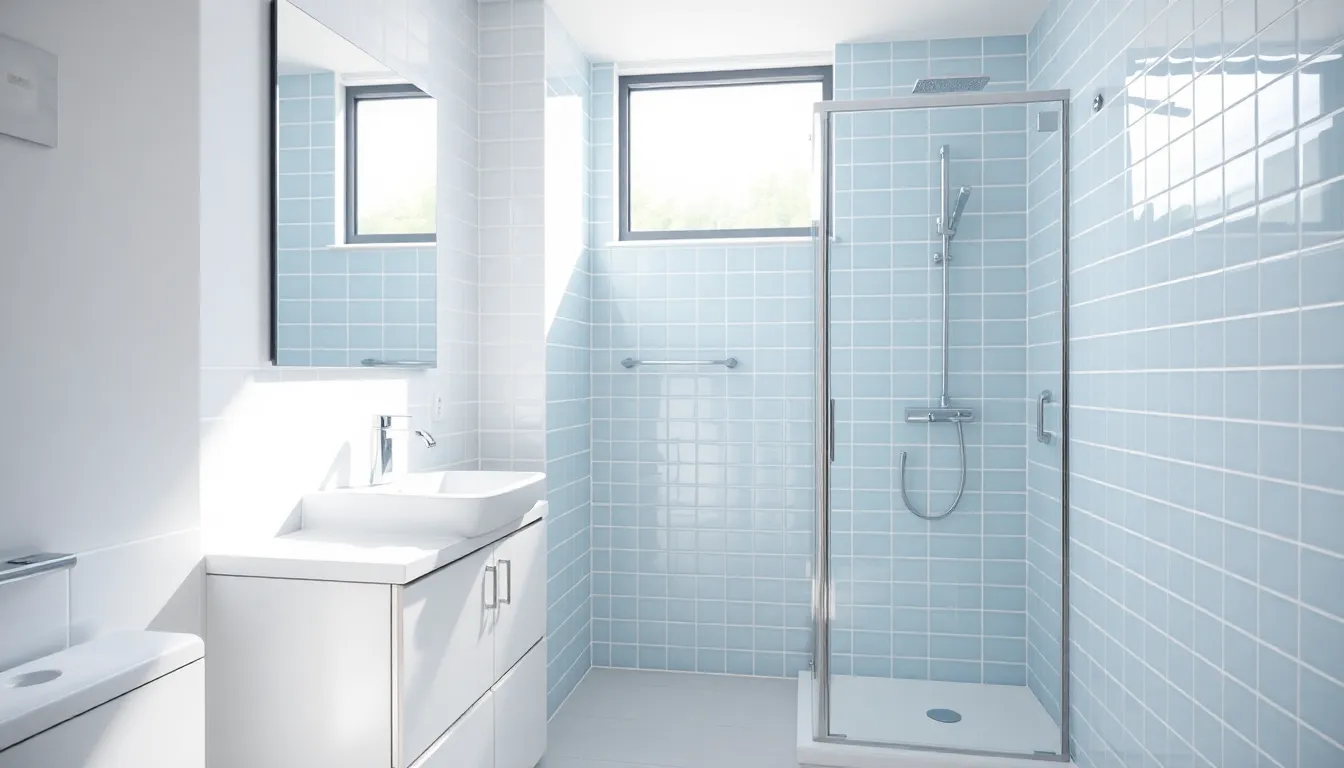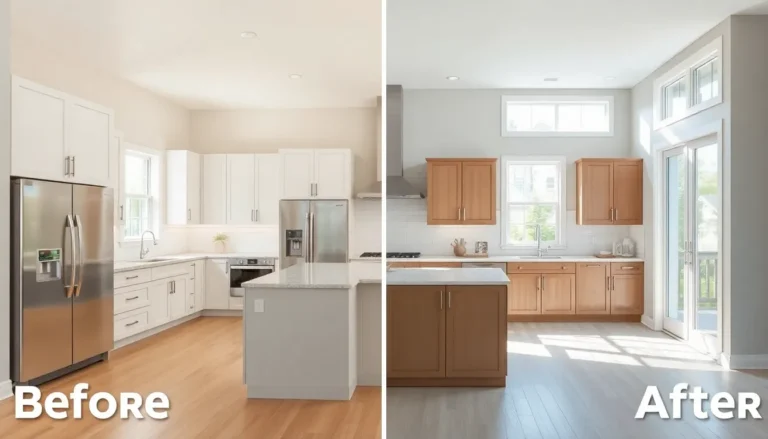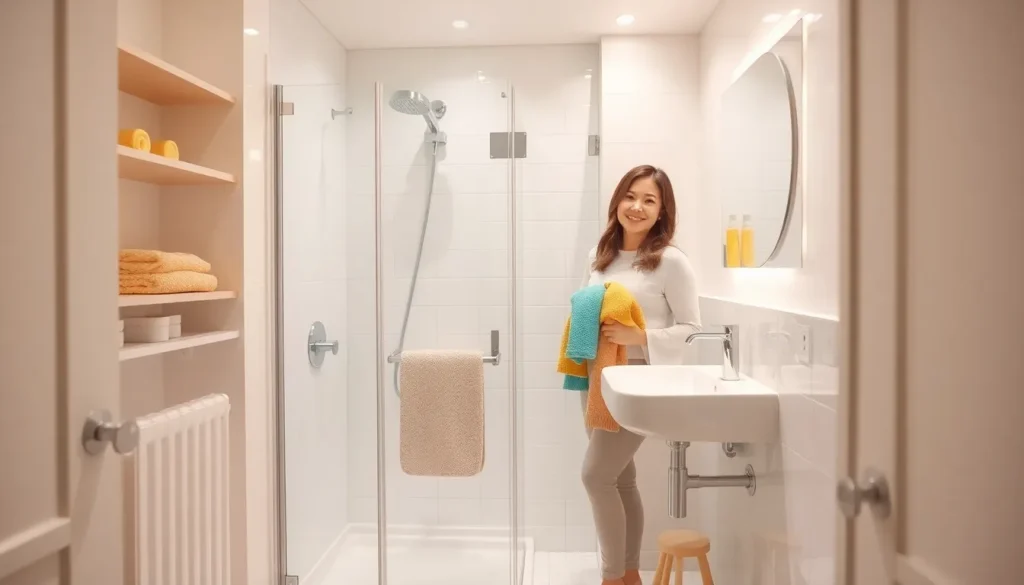Table of Contents
ToggleSmall bathrooms can feel like a cozy nook or a claustrophobic nightmare—it’s all about how you choose to remodel. With a little creativity and a splash of style, even the tiniest of spaces can transform into a luxurious retreat. Imagine stepping into a bathroom that feels more like a spa than a shoe box. Sounds dreamy, right?
Overview of Small Bathroom Remodelling
Small bathroom remodelling turns limited spaces into functional and stylish areas. Clever design choices maximize both utility and aesthetics. Prioritizing storage solutions is crucial; using vertical space with shelves or cabinets creates additional room. Selecting a light color palette enhances brightness and gives an illusion of spaciousness.
Incorporating mirrors helps reflect light and adds depth. Fixtures such as wall-mounted sinks save valuable floor space. Choosing a glass shower enclosure instead of bulky curtains also opens up the area visually.
Budget considerations play a significant role in planning. Cost-effective materials, like vinyl flooring or laminate countertops, offer stylish options without excessive spending. Quality fixtures may save on water bills over time, balancing upfront costs with long-term savings.
Design trends indicate that incorporating natural elements fosters relaxation. Elements like wood accents or plants can infuse warmth and comfort. Implementing smart technology also adds convenience; features such as programmable lighting and heated floors enhance the user experience.
Analyzing the space’s layout can reveal opportunities for structural modifications. Sometimes, removing a partition or repositioning fixtures can dramatically improve flow.
Every small detail contributes to the overall atmosphere. Lighting choices, such as recessed fixtures or sconces, can create ambiance while providing necessary illumination. Achieving the perfect balance between style and practicality transforms a small bathroom into a serene retreat.
Planning Your Small Bathroom Remodel

Effective planning transforms small bathrooms into functional retreats. Key elements include budget considerations and design style choices.
Budget Considerations
Establishing a budget maintains focus during the remodeling process. Allocate funds for essential updates like plumbing fixtures and flooring. Prioritize spending on quality materials to ensure durability and long-term value. Research local prices to identify cost-effective options without sacrificing quality. Consider DIY tasks to cut costs on labor while boosting personal investment in the project. Utilize online resources for estimating materials and labor, ensuring budget accuracy. Always maintain a contingency fund for unexpected expenses, which often arise during renovations.
Choosing a Design Style
Selecting a design style influences the remodel’s overall feel. Modern, minimalist themes often create a spacious illusion in small areas. Incorporating natural elements like wood or stone fosters relaxation, contributing to a spa-like atmosphere. Traditional styles may use ornate tiles or classic fixtures, providing warmth and charm. Consider contemporary trends that emphasize clean lines and simplicity. Evaluate existing elements within the bathroom, such as cabinetry or tile, to guide style choices. Remember that cohesion is essential; maintain consistency across colors, materials, and fixtures for a harmonious look.
Optimizing Space in Small Bathrooms
Optimizing space in small bathrooms makes a significant impact on both functionality and comfort. Clever design choices enhance the overall experience.
Smart Storage Solutions
Maximizing storage in small bathrooms involves innovative solutions that keep clutter at bay. Floating shelves offer attractive space for displaying decor or storing essentials. Over-the-toilet cabinets make use of typically wasted space. Under-sink organizers keep items neatly stored and accessible. Built-in niches provide functional storage for toiletries within the shower area. Basket organizers allow easy access to smaller items, maintaining a streamlined appearance. Wall hooks add quick storage for towels or robes, ensuring easy reach.
Layout Considerations
Thoughtful layout considerations improve flow and accessibility in tight spaces. Positioning fixtures thoughtfully reduces obstruction and enhances usability. Utilizing corner sinks or vanities maximizes floor area without sacrificing functionality. Choosing a pocket door instead of a swinging door saves valuable space. Arranging larger fixtures along one wall avoids cramped feeling. Space beneath the sink can be repurposed for additional storage, while clear pathways enhance movement. Opting for a radial layout, where the toilet sits away from the walls, creates an open atmosphere.
Selecting the Right Materials and Fixtures
Choosing the right materials and fixtures significantly impacts the overall aesthetic and functionality of a small bathroom. Quality selections can enhance durability while also contributing to a cohesive design.
Flooring Options
Tile flooring remains a popular choice for small bathrooms due to its water resistance and variety of styles. Natural stone tiles offer a luxurious touch, although they may require more maintenance. Vinyl planks provide a budget-friendly alternative, with options that mimic wood or stone while being easier to clean. Porcelain tiles also serve as a durable solution, suitable for high-traffic areas. Smaller-sized tiles can create the illusion of space, while light-colored surfaces reflect more light, enhancing brightness.
Vanity and Sink Choices
Vanities with integrated sinks maximize space and reduce clutter. Prefab options offer affordability, while custom designs can cater to specific dimensions. Wall-mounted vanities create an open feel and allow for easy floor cleaning. Choosing a vessel sink can add a unique touch but may necessitate additional countertop space. Opting for compact models, like pedestal sinks, can save critical inches in tight areas. Materials such as quartz or granite provide durability while contributing to an elegant appearance.
Lighting and Color Schemes
Lighting significantly affects the atmosphere of a small bathroom. Bright, well-placed lighting creates an inviting environment, while dark, shadowy corners can make a space feel cramped. Layering light sources, such as combining overhead lights with sconces or LED strips, enhances functionality and aesthetics.
Natural light is also vital. If a window exists, keep treatments minimal to maximize brightness. In spaces lacking windows, opt for bright, cool-toned bulbs to mimic daylight, which can help alleviate a confined feeling.
Selecting the right color scheme is equally important. Light colors, like whites, pastels, and soft neutral tones, instill a sense of openness. Incorporating these hues on walls and fixtures promotes a more spacious appearance. For a touch of personality, consider adding darker accents through accessories or artwork.
Incorporating mirrors amplifies light and creates an illusion of depth. Placing a large mirror opposite a light source enhances brightness and makes the bathroom appear larger. Smaller decorative mirrors can also serve as stylish focal points, contributing to a layered visual effect.
Finishing touches like colorful towels or coordinating accessories inject vibrancy without overwhelming the space. Utilizing cohesive color schemes throughout the bathroom maintains visual harmony and enhances the overall design.
Choosing fixtures with polished finishes or chrome adds to the reflective quality of the space. This choice not only provides a modern feel but also complements lighter color palettes, reinforcing the airy atmosphere.
Conclusion
Transforming a small bathroom into a stylish retreat is entirely achievable with thoughtful design and planning. By prioritizing smart storage solutions and selecting the right materials, it’s possible to maximize both functionality and aesthetics.
Incorporating elements like mirrors and light colors can significantly enhance the perception of space while creating a serene atmosphere. Budgeting wisely and considering DIY options can also lead to a successful remodel without overspending.
Ultimately, the key lies in creating a cohesive design that reflects personal style while ensuring comfort and usability. With the right approach, even the smallest bathrooms can become inviting sanctuaries that blend practicality with elegance.





